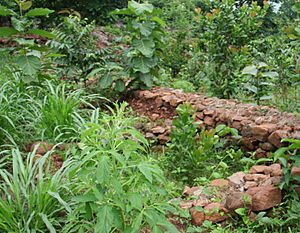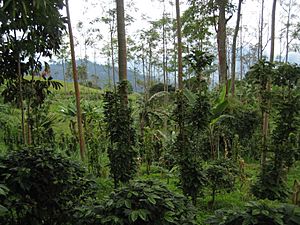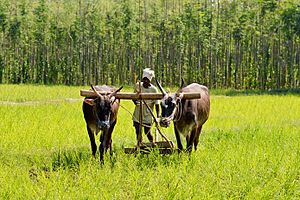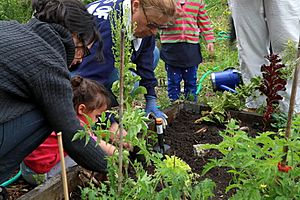Sustainable agriculture facts for kids
Sustainable agriculture is a way of farming that helps us grow food and make clothes without hurting the Earth for people now or in the future. It's about understanding how nature works and using smart methods to farm.
Farming today has a big impact on our planet. It can cause climate change, use too much water, pollute rivers, damage land, and lead to cutting down forests. Sustainable agriculture uses Earth-friendly ways to grow crops and raise animals without harming the soil, water, animals, or people. It includes ideas like permaculture (designing farms like natural ecosystems), agroforestry (growing trees and crops together), and crop rotation (changing what you grow in a field).
Creating sustainable food systems helps everyone. For example, using sustainable agriculture is one of the best ways to fight climate change. It helps us feed more people as the world's population grows, even with changing weather. Besides sustainable farming, choosing sustainable diets (like eating less meat) also helps the environment a lot. There are many labels, like organic and Rainforest Alliance, that show food was grown in a sustainable way.
Contents
What is Sustainable Farming?
The idea of "sustainable agriculture" became official in 1977. The USDA said it's a way of farming that:
- Gives people enough food and materials (like cotton).
- Makes the environment better and protects the natural resources farms depend on.
- Uses resources that can't be replaced (like oil) very wisely.
- Helps farms stay in business and make money.
- Makes life better for farmers and everyone else.
But people in indigenous communities (native groups) have been farming in Earth-friendly ways for hundreds of years, long before this term was created.
Why is Sustainable Farming Important?
Many people agree that sustainable farming is the best way to feed the growing number of people on our planet. To do this, farmers must think about the future costs to the environment and the communities they serve. New technology is helping farms grow more food sustainably. The goal is to feed everyone around the world. People are worried that the Earth might not be able to produce enough food for everyone, so sustainable farming is becoming more popular.
Main Ideas of Sustainable Farming
Here are some key principles of sustainable agriculture:
- Working with nature: Using natural processes like recycling nutrients in the soil, making soil healthy again, and plants taking nitrogen from the air.
- Using less harmful stuff: Reducing the use of resources that run out, especially those that hurt the environment.
- Trusting farmers' knowledge: Helping farmers use their skills to work the land well and become more independent.
- Working together: People with different skills cooperating to solve farm problems like pest management and irrigation.
Sustainable farming looks at money in the long term, not just short term. It aims for farming environments that can keep growing food forever. It also balances the need to protect resources with farmers needing to make a living. It's like reconciliation ecology, where nature and human activities can exist together. Often, sustainable farming uses smart, Earth-friendly tools.
How Farming Affects the Environment
Some farming methods can harm the soil over time. For example, tilling (plowing) the soil too much can lead to erosion (soil washing or blowing away). Also, watering crops without good drainage can make the soil too salty.

The most important things for a farm are climate, soil, nutrients, and water resources. Farmers can do a lot to protect water and soil. When farmers harvest crops, they take nutrients from the soil. If these nutrients aren't put back, the land becomes unhealthy and can't grow as much food. Sustainable agriculture focuses on putting nutrients back into the soil while using fewer resources that can't be replaced, like natural gas.
A farm that grows food forever but harms the environment somewhere else is not truly sustainable. For example, using too much fertilizer can help a farm, but it can also pollute nearby rivers and oceans. On the other hand, if farms don't use enough nutrients, crops won't grow well, which can lead to more forests being cut down for new farmland.
Nutrients for Plants
Plants need nutrients to grow, just like we need food.
Nitrates
Nitrates are a common type of fertilizer. A big problem with farming is that nitrates can leak into the environment and cause pollution. Sustainable ways to get nitrates include:
- Recycling plant waste and animal manure.
- Growing special plants like legumes (peanuts, alfalfa) that work with tiny bacteria to pull nitrogen from the air into the soil.
- Making nitrogen in factories using renewable energy.
- Even changing plants through genetic engineering so they can get nitrogen from the air themselves!
Sustainable farming also uses long-term crop rotations (changing crops in a field over many years) and bringing back natural cycles like river floods that add nutrients to the soil.
Phosphate
Phosphate is another key nutrient for plants, second only to nitrogen. It helps soil stay healthy and makes crops grow better. It's important for plant processes like photosynthesis and strong roots.
Most phosphate fertilizers come from rock phosphate. But rock phosphate is a resource that will run out. Using too much of these chemical fertilizers can also harm tiny living things in the soil and pollute water. So, sustainable farming looks for other ways to get phosphate.
Potassium
Potassium is a very important nutrient for plants. It helps crops hold water, improves their taste and color, and makes them stronger against diseases. It's used for growing many foods like grains, fruits, and vegetables.
The most common potassium fertilizer is potassium chloride (KCl). But using too much KCl can make the soil salty and harm tiny living things in the soil. This can hurt soil biodiversity and how much food farms can grow. Sustainable farming tries to use chloride-free fertilizers that are better for soil health.
Healthy Soil

Damaged land is a big problem worldwide. Experts say that about a quarter of the Earth's land (not covered by ice) is harmed by human activities. Soil erosion from farms is much faster than how soil naturally forms. Bad soil management makes it harder to grow enough food.
Intensive farming (growing a lot of crops very quickly) can reduce the carbon in the soil. This harms the soil structure, how well crops grow, and even speeds up climate change. Changing farming methods can help put carbon back into the soil, making it a "carbon sink."
Good soil management includes methods like no-till farming (not plowing the soil), planting windbreaks (rows of trees) to stop wind erosion, adding organic matter back to the soil, reducing salty soil, and stopping water from running off.
Land Use
As more people live on Earth, we need more food, which puts pressure on land. How we use land affects things like soil erosion. For example, a study in the Middle East showed that dividing land into many small plots caused more soil erosion than animals grazing.
In the past, poor people often couldn't afford to farm in Earth-friendly ways. Today, land damage in developing countries can be linked to poverty among small farmers who are forced to use unsustainable methods.
Turning large areas of land into farms can have serious effects on the environment and health. For example, it can lead to more diseases that spread from animals to humans (like COVID-19). This happens because natural areas that separate humans and animals are destroyed, reducing biodiversity.
Land is a limited resource. While expanding farmland can reduce biodiversity and cause deforestation, it's a complex issue. The Food and Agriculture Organization thinks that in the future, farmland will continue to be lost to cities and industries, and forests will be cut down for farming. This will lead to more loss of different kinds of life and soil erosion.
Energy Use in Farming
Modern farming uses a lot of energy for machines, processing food, storing it, and transporting it. So, energy prices are closely linked to food prices. Oil is also used to make farm chemicals. Experts predict that non-renewable energy sources will become more expensive as they run out. This could make it harder to get enough food worldwide unless we find ways to make food without relying so much on fossil fuels. We need to move towards "energy-smart" farming systems that use renewable energy, like solar power for irrigation.
Also, if people buy local products, it can reduce the environmental cost of transportation.
Water Use in Farming
Some areas get enough rain for crops, but many others need irrigation (watering crops). For irrigation to be sustainable, it must be managed well to avoid making the soil salty. Also, farms must not use more water than can be naturally refilled. If they do, the water source will eventually run out.
New technology for drilling wells and using pumps has made it possible to grow a lot of crops in dry areas. But this has a cost. In many places, like the Ogallala Aquifer in the US, water is being used up faster than it can be replaced.
To make farming more resistant to dry periods, even in normal years, we need to:
- Improve how we save and store water.
- Encourage farmers to choose crops that can handle dry conditions.
- Use irrigation systems that use less water.
- Manage crops to reduce water loss.
- Sometimes, not plant crops at all in very dry times.
Farming uses about 69% of the world's fresh water.
Challenges for Sustainable Farming
There are three main challenges to sustainable agriculture: social, environmental, and economic. All three must be addressed to make sustainable farming work.
- Social Challenges: These include changing old habits, getting farmers to work together, and creating reasons for people to switch to sustainable methods. Moving from traditional farming to sustainable farming means big changes for farmers and consumers. Farmers might worry about competition and making money. Laws and public awareness campaigns can help overcome these social barriers.
- Environmental Challenges: These include using pesticides and the effects of climate change. Pesticides are used to kill pests and keep food prices low. To be sustainable, farmers are encouraged to use "green" pesticides that are less harmful, even if they cost more. Climate change is also a big challenge that farmers can't control, like bad weather or poor soil quality, which can lead to crop losses. This makes farmers hesitant to change. Many environmental benefits of sustainable farming, like healthier soil, take time to appear. In traditional farming, benefits like no weeds are seen quickly, but the long-term harm to the environment is often hidden.
- Economic Challenges: These include lower profits, lack of money help, and the cost of new equipment. Changing to sustainable methods needs training for workers and investments in new technology, which can be expensive. Farmers using traditional methods can often grow huge amounts of crops and make more money. This can be harder with sustainable farming, which often focuses on smaller, more careful production.
Some people believe that true sustainability means going back to very old, traditional farming methods. Others see sustainable agriculture as important steps towards a better future. One good way to encourage sustainable farming is through local farming and community gardens. Teaching kids and communities about local produce can help people want more fresh, local food.
Some people imagine a truly sustainable future where we use much less energy, have a very small ecological footprint, buy local food, eat less processed food, and have more home and community gardens.
Related Ideas
Organic Farming
Organic agriculture is a farming system that aims for sustainability. It focuses on making soil healthy and increasing biological diversity (many different kinds of life). It usually avoids man-made pesticides, antibiotics, chemical fertilizers, and genetically modified organisms (GMOs).
Some people say that organic products are the most sustainable choice for consumers, even though the organic industry doesn't always focus on sustainability itself. In 2018, organic product sales in the USA reached $52.5 billion.
Ecological Farming
Ecological farming focuses on the environmental side of sustainable agriculture. It includes all methods, even organic ones, that help nature's services, like preventing soil erosion, helping water soak into the ground, storing carbon in the soil, and increasing biodiversity. Many techniques are used, like no-till farming, planting different kinds of crops together, and terrace cultivation (farming on slopes).
Ecological farming uses many methods to make agriculture more sustainable. For example, growing many different kinds of crops helps them be stronger against changing weather. This makes sure we have enough food. Another method is using "biodigestors," which turn organic waste into gas for fuel and fertilizer for crops and fish ponds. This reduces the need for factory-made fertilizers.
Combining fish farming with crop farming (aquaculture integration) is another technique. Waste from animals and crops can be used to feed fish, and mud from fish ponds can fertilize crops.
Organic fertilizers, like animal manure, also help. They make the soil healthy, reduce costs, and use fewer non-renewable resources. "Precision Agriculture" is another method that uses smart techniques to remove pests without chemicals and reduces how much the soil needs to be tilled. This helps keep the soil healthy.
Benefits of Ecological Farming
- It brings back helpful plants and animals to the farm, which reduces environmental damage.
- It's a smart way to manage land worldwide and encourages us to think about how important biodiversity is in farming.
- It can use new technology like robots and smart computer systems to help care for the soil and plants.
Challenges for Ecological Farming
The main challenge is to make ecological farming a common way to produce enough food that is sustainable. Also, where the farm is located matters. Being close to consumers reduces "food miles" (the distance food travels), which means less pollution from transportation.
Designing an ecological farm depends on the local climate, soil, budget, and available workers or machines. However, over time, ecological farming methods can save and increase water and need fewer outside resources to keep the soil fertile.
Main Ideas of Ecological Farming
- Food production should be ecological from start to finish (meaning how it's grown and how it gets to you).
- Include different kinds of plants and animals that help the ecosystem while providing various products.
- Use less energy, packaging, and create less waste.
- Create new farm ecosystems that meet human needs, learning from natural ecosystems.
- Use knowledge about tiny living things in the soil to make farming systems better, like in Forest Gardens.
See also
 In Spanish: Agricultura sostenible para niños
In Spanish: Agricultura sostenible para niños
- Agroecology
- Climate-smart agriculture
- Environmental impact of meat production
- Forest farming
- Local food
- Natural farming
- Sustainable Agriculture Innovation Network
- Sustainable Commodity Initiative
- Sustainable development
- Sustainable energy
- Sustainable food system
- Sustainable landscaping




